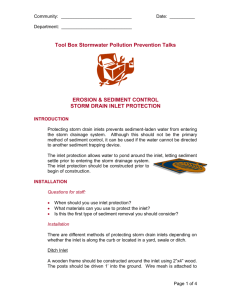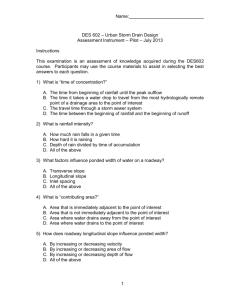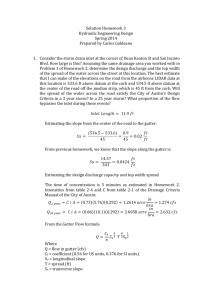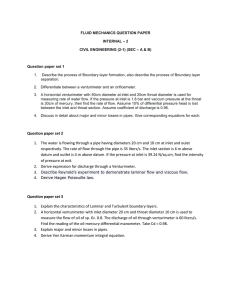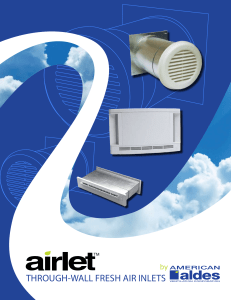Project Summary 0-5823: Hydraulic Performance Evaluation of Horizontal Inlet Type-H Background
advertisement
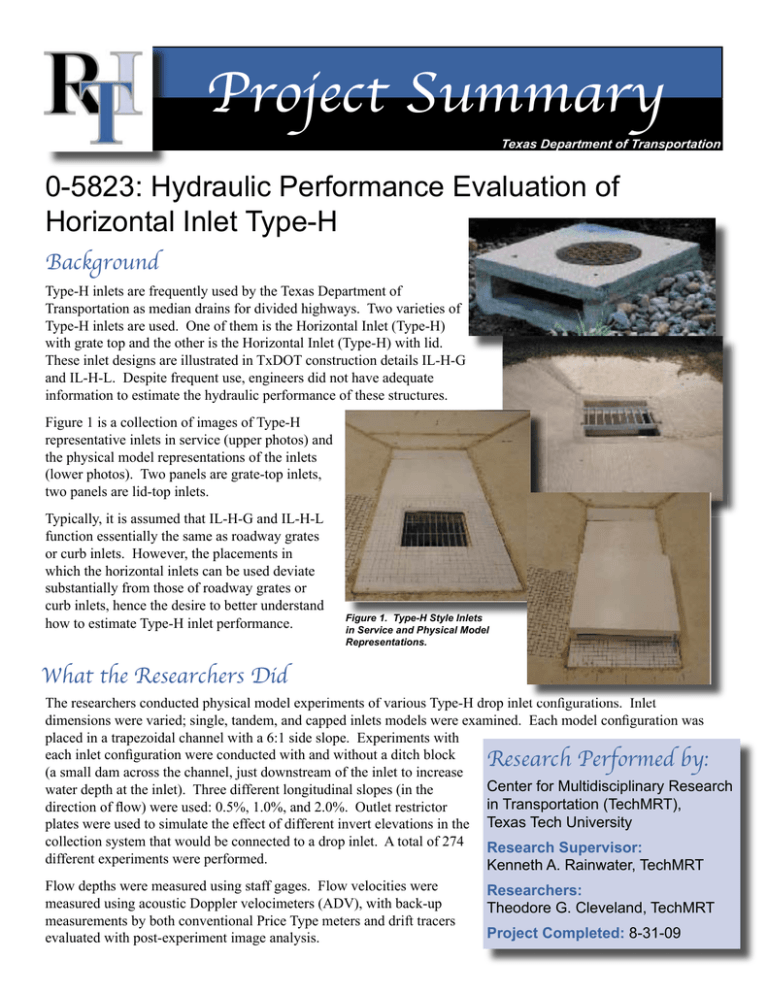
Project Summary Texas Department of Transportation 0-5823: Hydraulic Performance Evaluation of Horizontal Inlet Type-H Background Type-H inlets are frequently used by the Texas Department of Transportation as median drains for divided highways. Two varieties of Type-H inlets are used. One of them is the Horizontal Inlet (Type-H) with grate top and the other is the Horizontal Inlet (Type-H) with lid. These inlet designs are illustrated in TxDOT construction details IL-H-G and IL-H-L. Despite frequent use, engineers did not have adequate information to estimate the hydraulic performance of these structures. Figure 1 is a collection of images of Type-H representative inlets in service (upper photos) and the physical model representations of the inlets (lower photos). Two panels are grate-top inlets, two panels are lid-top inlets. Typically, it is assumed that IL-H-G and IL-H-L function essentially the same as roadway grates or curb inlets. However, the placements in which the horizontal inlets can be used deviate substantially from those of roadway grates or curb inlets, hence the desire to better understand how to estimate Type-H inlet performance. Figure 1. Type-H Style Inlets in Service and Physical Model Representations. What the Researchers Did The researchers conducted physical model experiments of various Type-H drop inlet configurations. Inlet dimensions were varied; single, tandem, and capped inlets models were examined. Each model configuration was placed in a trapezoidal channel with a 6:1 side slope. Experiments with each inlet configuration were conducted with and without a ditch block Research Performed by: (a small dam across the channel, just downstream of the inlet to increase Center for Multidisciplinary Research water depth at the inlet). Three different longitudinal slopes (in the in Transportation (TechMRT), direction of flow) were used: 0.5%, 1.0%, and 2.0%. Outlet restrictor plates were used to simulate the effect of different invert elevations in the Texas Tech University collection system that would be connected to a drop inlet. A total of 274 Research Supervisor: different experiments were performed. Kenneth A. Rainwater, TechMRT Flow depths were measured using staff gages. Flow velocities were measured using acoustic Doppler velocimeters (ADV), with back-up measurements by both conventional Price Type meters and drift tracers evaluated with post-experiment image analysis. Researchers: Theodore G. Cleveland, TechMRT Project Completed: 8-31-09 The principal data collected were the approach depth, approach discharge, inlet discharge, and overflow discharge. These data in combination with the known geometry of the approach channel and inlet constitute the type of information required to use the HEC-22 guidelines for estimating the performance of an inlet for design purposes. In addition to the actual physical model experiments, literature-derived values of the same kind of information were collected from similar experiments reported from prior research. Most of these data were inferred from various Federal Highway Administration reports and earlier work in support of highway drainage. These two data sets (prior literature derived values, and actual physical model experiments) were analyzed using various power-law models of dimensionless relationships suggested in prior literature. The existing HEC-22 procedures were evaluated for their ability to estimate inlet performance of the physical model. A Storm Water Management Model (SWMM) modeling procedure was also developed as an alternate performance estimation/ prediction tool. What They Found The physical model experiments are consistent with similar experiments found in the literature with respect to inlet capture capability and its relationship to approach flow conditions. Type-H grate-top inlets, as studied, perform similar to the HEC-22 expectations using a P-30 type grate as an approximation to the Type-H behavior, in non-sag configurations (without a ditch block). Type-H inlets, as studied, perform similar to the HEC-22 expectations when the weir-type equations are applied (Equation (4-26) in HEC-22) in a sag configuration (with a ditch block). Submerged orifice-type equations could not explain the physical model experiments or the literature-derived observations. A power-law model that uses the dimensionless groups, with the slopes omitted, and a researcher-defined morphology index, provides a reasonable explanation of inlet behavior, but never predicts full capture (all flow into the inlet), even though this condition was witnessed in both our physical model and the literature-derived observations. What This Means 1. Use of the HEC-22 procedure with the P-30 type grate as an approximation to the Type-H grate in non-sag conditions is appropriate for Type-H performance prediction. 2. Use of the HEC-22 weir-type equations for Type-H inlets in sag conditions is appropriate. The researchers do not believe that orifice-type equations are appropriate unless the sag condition is such that ponded depths will substantially exceed the inlet diagonal dimension (at least a factor of 2). 3. Use of the SWMM program is an appropriate alternate tool for cases where outlet hydraulics are anticipated to exert substantial control over inlet system performance. SWMM or similar programs would be of value when a series of inlets must be considered because of the potential time savings and ability to rapidly consider many different design configurations. For More Information: Research Engineer - Wade Odell, TxDOT, 512-416-4730 Project Director - Stan Hopfe, TxDOT, 512-832-7329 Research Supervisor - Kenneth A. Rainwater, TechMRT, 806-742-3597 Technical reports when published are available at: http://library.ctr.utexas.edu/index.html www.txdot.gov keyword: research Research and Technology Implementation Office P.O. Box 5080 Austin, Texas 78763-5080 512-416-4730 This research was performed in cooperation with the Texas Department of Transportation and the Federal Highway Administration. The contents of this report reflect the views of the authors, who are responsible for the facts and accuracy of the data presented herein. The contents do not necessarily reflect the official view or policies of the FHWA or TxDOT. This report does not constitute a standard, specification, or regulation, nor is it intended for construction, bidding, or permit purposes. Trade names were used solely for information and not for product endorsement.


